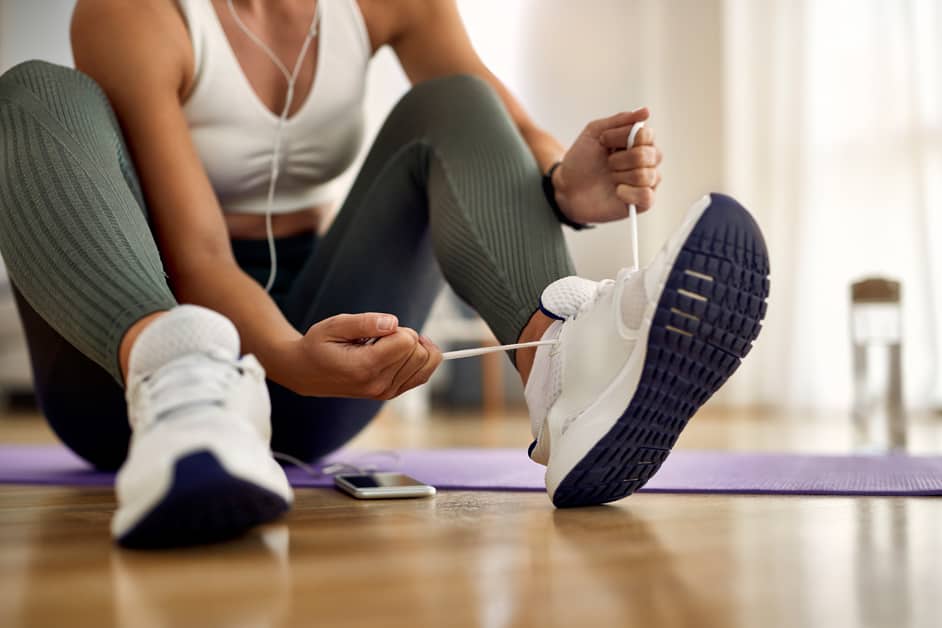Understand the Different Types of Running Shoes
Finding the ideal running shoes for anyone enduring knee pain is essential. Varieties of running shoes offer cushioning, stability, and support which can alleviate pain. Knowing the different types of running shoes and their pros can help you pick the best one.
Let’s talk about the various running shoes and their features and advantages:
Cushioned Shoes
Cushioned shoes offer top shock absorption, perfect for those with knee pain. Running on hard surfaces? No problem. These shoes ease pressure on your lower legs and knees. They’re ideal for pavement and trails. Plus, they provide comfort and reduce joint stress.
These shoes have thick midsoles made of foam. They cushion your feet and keep cushioning for a long time. The uppers are lightweight for better airflow and ventilation. Depending on the model,
- adjustable lacing systems,
- reinforced heels, and
- non-slip rubber outsoles
may be included. Plus, multi-directional traction for smooth transitions when running.
Motion Control Shoes
Motion control running shoes are crafted to give extra stability and guard against overpronation. Their midsole is stiffer than other types of shoes. This helps control how the foot rolls inward when walking or running. They are ideal for people with severe overpronation who need more structure and support in their sneaker. The cushioning is stronger to protect against heel pain and ankles rolling in too far, reducing pressure on knee joints.
Features:
- Robust cushioning – thicker midsoles absorb impact shock better.
- Stability system – arch-shaped sole for comfort and stability for overpronators.
- Durable materials – strong overlays and supportive layers for added durability.
- Wide heels base – prevents feet from sliding too much during foot strikes.
Stability Shoes
Stability shoes are for runners who overpronate. Their outsoles are thicker to support the foot when it lands. Cushioning helps absorb shock. A post in the midsole stretches from inside to outside, controlling pronation and limiting motion. These shoes give more support than neutral shoes and help with knee pain. They also allow proper foot movement during running.
Consider the Fit
Choosing the finest running shoes for those who experience knee pain needs you to consider some specific factors. Fit is the most important one. If the shoe doesn’t fit correctly, it can cause the knee to move in a way that puts extra pressure on the joint. So, it’s important to try different shoes to find the ideal fit.
Furthermore, cushioning and arch support of the shoe are also key factors to think about when picking the appropriate shoe.
Measure your feet
A proper fit is essential, especially for runners with knee pain. Measure both feet in inches and centimeters. Note the width and circumference, and the heel measurements. Shoes should offer shock absorption and arch support to prevent knee pain.
Visit a store that offers a selection and one-on-one attention. Preferably, find a store specialized in running gear with knowledgeable staff.
Make sure the shoes aren’t too tight or loose around the heel and toes. There should be room for one finger at the back. The shoe should have enough space from front-to-back so your toes don’t hit the end when you walk or run uphill. Finally, confirm your feet fit snugly into the midsole before buying:
- The shoes shouldn’t be too tight or loose around the heel and toes.
- There should be room for one finger at the back.
- The shoe should have enough space from front-to-back.
- Confirm your feet fit snugly into the midsole.
Try on different sizes and styles
Knee pain can be hard to manage. To find the best fit for your feet, try on various shoes. Consider size, width, and length. If you order shoes online, ask the store about their return policy. Style matters too. Shoes should fit your feet’s shape and size. Make sure to check for cushioning and grooves in the sole. Gait analysis is also beneficial. It can reveal any pronation or supination issues.
And don’t forget to try out the shoes before you commit. This will ensure they prevent knee pain!
Look for a snug fit
When seeking knee pain relief through running shoes, make sure they fit snugly. Not too tight, but comfy and secure. An ill-fitting pair can cause extra strain on your joints and lead to increased knee pain.
For the right fit, try on different sizes and types of shoes. Compare brands and models – make sure there’s enough space around your toes while the heel still stays in place when you run. Wear the shoes around the house for a while before going out on a long run, to make sure they are comfortable.
Research the Brand
Research is key when it comes to finding the best running shoes for knee pain sufferers. Check customer reviews and ratings. Analyze the materials and construction of the shoes. Make sure they offer support and cushioning to lessen knee strain. Plus, some brands may offer discounts or promo codes, making it easier to buy the right shoes!
Read customer reviews
Choosing the perfect running shoes? Customer reviews are key! Read what others have to say about their running shoes for essential information about which brands and styles work best. It’s especially useful to read reviews from people with similar knee pain.
Online reviews are easy to find—check out manufacturer websites, retail sites like Amazon or Zappos, and specialized forums or sites like Runner’s World or Good Housekeeping. Look out for mentions of comfort, support, and style. Pay attention to customer ratings too—they’ll tell you how buying a certain pair of running shoes worked out for different people over time. Also, read if any reviewers have experienced chafing, pinch points, or unexpected discomfort—these could be prevented if you buy the right shoes.
Research the brand’s reputation
Research is key when searching for the right running shoes for knee pain sufferers. Check customer reviews online and ask your friends who have used the same brand. Look for a reputable brand that has been around a long time. Research each model to find out which one has the features that support the knees and reduce pressure.
Consider special features such as arch support, cushioning, shock absorption, water resistance and sweat-wicking capabilities. Doing your research will help make an educated choice in finding running shoes that ease knee pain.
Consider the Technology
Choosing running shoes for knee pain? Technology matters! Different shoes have various tech that can help reduce discomfort. Let’s look at what tech is available and how it can help relieve knee pain when running:
Look for shoes with cushioning technology
When searching for running shoes to alleviate knee pain, look for styles with cushioning technology. This technology provides compression and shock protection, meaning your feet will experience less impact.
The technology used in the shoes varies by brand. Some use Allite foam or Respon-Tek cushions, while others utilise a midsole layer of lightweight foam combined with firmer foam components. It is important to consider the type of cushioning technology when selecting a style that will help reduce your knee pain.
Popular cushioning technologies include:
- Air Max: Fabric layer sandwiched between two foams for reduced impact and maximum cushioning.
- ENCAP Midsole Technology: Found on New Balance models, this style has a polyurethane rim around a resilient foam core for stability and cushioning.
- Adidas BOOST: Responsive cushion that stores and releases energy quickly with each stride.
- Ortholite Foam Insole: Breathable insole with memory foam padding for comfort.
- Air Zoom Vomero: Pressure mapping guides changes, with zoom air units under key areas of the foot for dynamic energy return.
Take time to find a shoe that fits correctly and feels comfortable. This will ensure that you have effective protection against excessive joint strain while running or walking.
Look for shoes with arch support technology
When it comes to finding the right running shoe with arch support technology, there are a few key elements to consider. Start by looking for shoes with cushioning materials. Brands like Nike and Reebok have their own cushioning technologies, like Zoom Air and DMX foam, that provide shock absorption and help prevent knee pain.
Next, inspect the midsole design of the shoe. It should include an arch support system and additional cushioning layers. This will help reduce pressure on your foot and allow for a stable footing, even on tough terrain. It can also correct pronation issues associated with knee problems by providing adequate stability without compromising strength in important areas like the feet and ankles.
Finally, search for shoes with moisture-wicking capabilities. This helps keep your feet dry and prevents sweat buildup while running. Many shoe manufacturers use specific fabrics as barriers against moisture and wick away sweat and water quickly. This keeps you feeling comfortable and dry on hot days outside or longer runs.
When looking for the perfect running shoe with arch support technology, make sure to look for:
- Premium cushioning materials from major brands.
- An arch support system in the midsole design.
- Moisture-wicking fabrics for comfort.
Consider Your Budget
Knee pain is a drag. It can ruin a running routine. To protect your joints, you need running shoes with good shock absorption. The good news is that there are many affordable options. When shopping for running shoes for knee pain, think about your budget.
Set a budget
When picking the perfect running shoes for knee pain, budget is key. Prices can range from $50 to $200, depending on brand and features. Think about your exercise habits and running goals to decide how much to spend. If you do long runs regularly or have an existing injury, invest in a higher-end pair. It’ll have features to protect your knees and keep you comfortable. Occasional joggers or runners don’t need those features, so it’s ok to choose a cheaper option.
Shop around! Look online or at discount stores to save money. Don’t just focus on price. Research brands to make sure they won’t cause problems with your knees. At the end of the day, pick the shoes that’ll help you stay healthy and comfy!
Look for sales and discounts
If you want to buy running shoes for knee pain sufferers, it’s important to find ones that are comfy, fit your foot and provide cushioning and support. Shopping can be pricey, so think about your budget.
Check for sales or discounts online or in store. Shop at peak times like Black Friday or Cyber Monday for extra savings. Search online for special codes to save even more. Ask customer service at the retailer about any discounts they offer.
You can also save money by buying an older style of running shoe. Companies often release new versions of popular models, but the older versions can still offer quality cushioning and stability – at lower prices! This is a good way to get quality shoes without paying top dollar.
Consider buying used shoes
When searching for the best running shoes for knee pain, check out second-hand or used options. If you’re on a tight budget, buying used is a great idea. Thrift stores and online classifieds are great for finding gently used and affordable running shoes.
Inspect the soles for signs of wear and tear. If there are holes through the sole or worn down treads, then they won’t give enough support. Look out for smells. This could mean improper sanitation from previous use. Inspect inside the shoe for rips or tears, and the overall comfort level. If anything feels off, it’s best to look elsewhere.
Frequently Asked Questions
Q: What type of shoes are best for runners with knee pain?
A: Motion control or stability running shoes are often recommended for runners with knee pain. Motion control shoes help to limit excessive pronation and provide more stability to the foot, while stability shoes provide moderate support and cushioning.
Q: What should be considered when choosing the right size of running shoes?
A: The right size of running shoes depends on the size of your feet. It is recommended to measure your feet size and try the shoes on before buying. It is also important to make sure the shoes are wide enough and provide enough space for your toes to move.
Q: What other factors should I consider when buying running shoes for knee pain?
A: It is important to consider the cushioning, arch support and overall comfort of the shoes. Knee pain sufferers should also find shoes that provide good shock absorption and are lightweight.





